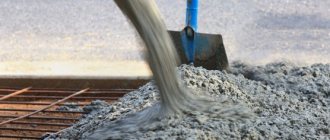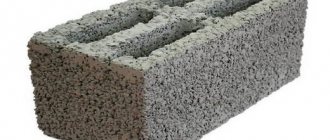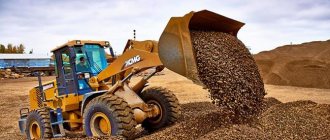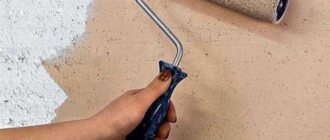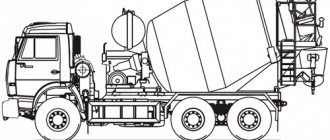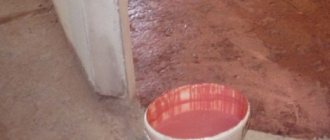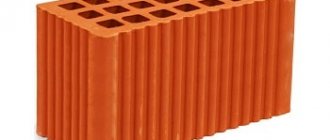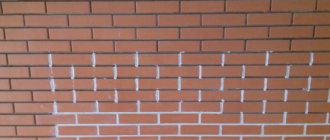Expanding cement mixtures - what is it?
This is the name given to a special prefabricated group of several cements with certain additives, leading to an increase in the volume of the product. This feature of this material helps to fill all voids and cracks, and this is extremely necessary for the high-quality construction of various monolithic reinforced concrete structures. Also, such cement is widely used in the construction of all kinds of tunnels and mines. As for household use, it is not very advisable due to its high cost. Although it should be noted, expanding cement perfectly restores damaged walls in old buildings, while significantly saving on the consumption of other materials.
This group of cements is usually called, in accordance with the characteristics of its production, gypsum-alumina expanding cement. It contains aluminous bases to which various components are added to promote greater expansion, for example:
- magnesium oxide hydrate;
- calcium hydrosulfolumipate;
- aluminum and calcium chloride sulfates;
- aluminum powder;
- sulfite-alcohol stillage.
The addition of these substances is quite justified, since they react in a rather unique way to increased humidity, thereby starting the decomposition process. As a result of this, new elements are formed that have an increased volume. Subsequently, they bind to cement molecules, thereby increasing its size. It is significant that all these transformations do not in any way reduce the strength of cement, but on the contrary add to its reliability and durability. The most common additive among those listed is calcium hydrosulfolumipate, and the frequent use of this component is explained by its low price. The best component in terms of quality characteristics is magnesium oxide hydrate - it is the most advantageous among others, which in general do not differ much from each other.
Slag Portland cement
The Portland slag cement group of materials is a fully binding substance that hardens both in water and in air. Portland slag cement is produced by grinding Portland cement clinker material, as well as blast furnace type slag and gypsum material. Portland slag cement is also obtained by mixing all the elements during the grinding process of each type of material. The hardening process of slag cement occurs more slowly than that of Portland cement, this is especially noticeable when using the material in low temperature conditions (the explanation for the slow hardening is due to the presence of slag in the composition of the material).
But, with the finest grinding, where the slag content is only 30-35%, the hardening process will occur in a similar way to what happens when using Portland cement. Strength characteristics for slag Portland cement will be lower than when using standard Portland cement. The regulations for the regulatory production and use of slag cement are determined by GOST 970-61, which provides for the production of 4 grades depending on the compression force of the material - 400, 500, 600 and 300.
The main characteristics of slag Portland cement are reduced or moderate heat release characteristics during the solidification process, lower deformation characteristics in mortar or concrete - high-quality shrinkage of the material occurs in air, and high-quality swelling of the material in water. The material is recommended for use both for above-ground reinforced concrete structures and for underground structures. The material is often recommended for use in structures that interact with water, as well as with slightly mineralized water in underground groundwater.
Pros and cons of expansion cement
Whatever the ideal material, it always has a number of advantages and disadvantages. Let us list the available positive qualities of expanding cement:
- increased adhesive and strength characteristics;
- good filling of micro- and macrocracks;
- replacement of finishing plaster;
- resistance to chemical and atmospheric influences.
These advantages are inherent in any type of this material. However, it consists not only of expanding components, but also contains other substances that affect its characteristics. For example, there is a special type of expanding cement designed specifically for external work, and there is also a type of this material with improved adhesion or high corrosion protection.
Expanding cement has the following disadvantages:
- high cost;
- bad distribution;
- narrow profile;
- a lot of fakes.
When purchasing a product from reputable manufacturers and using it for its intended purpose, these disadvantages become insignificant compared to the savings that arise from replacing other materials with expanding cement.
Gypsum-alumina expanding cement GOST 11052 74 – material properties
Expanding cement has certain advantages and, at the same time, has weaknesses. Main advantages:
- increased service life. The material retains its performance characteristics for a long time;
- improved adhesion. As the volume increases, the cavities are uniformly filled and there is close contact with various surfaces;
- resistance to natural factors. The plasticity of expanding cement is maintained at subzero temperatures;
- resistance to aggressive environments. The material is not destroyed by acids, alkalis and other chemicals;
- There is no shrinkage during hardening. This factor avoids the appearance of cracks and ensures the integrity of the array;
Among the new types of cement developed in recent years, expanding non-shrinkage and prestressing cements have gained great scientific interest and practical importance.
- extended range of application. Cement is used for a variety of purposes, including finishing plastering;
- accelerated hardening. The expanding building material begins to set 10–15 minutes after pouring and finally hardens after 3 days;
- ability to perceive excess water pressure. Thanks to the increased water resistance, moisture cannot enter the hardened material;
- strength gain in air and water environments. The material retains its properties at high moisture concentrations, as well as in the open air;
- fire resistance. Gypsum-alumina material is resistant to elevated temperatures and open fire.
Along with its advantages, expanding building materials have weaknesses:
- increased cost. Acquisition costs significantly exceed the costs of purchasing traditional building materials;
- narrow focus. The offered materials are intended to solve only certain problems - improving adhesion, operation in aggressive environments.
Try to purchase building materials only from a trusted manufacturer and use them according to their intended purpose.
Where is expansive cement used?
Here it is necessary to clarify that this material actually has a very narrow application. The list of main works performed with its help looks like this. The mixture is used when work needs to be done:
- for filling cracks;
- for gluing reinforced concrete;
- in some cases for applying external plaster.
Experts know that there are micro- and macrocracks. The reasons for the appearance of the former are mechanical shocks during transportation or other influences. And although they are not always visible, this is an excellent niche for condensation to settle. Under the influence of moisture, microcracks expand, which over time turn into macrocracks visible even to the naked eye.
Since one of the leading characteristics of expanding cement is increased adhesion, when it is absorbed into the structure, it reliably fills all internal pores. These qualities are the reason for using this cement mixture to decorate the outside of the room, while inside, where the temperature is more stable, ordinary plaster is also suitable. Expanding cement works in the same way on macro cracks, although in this case more material will need to be used.
Private construction of low-rise buildings is often carried out using reinforced concrete floors. As a rule, they are placed in the upper parts of the walls and can sometimes be coated with a cementitious composition. However, in this case, there is a violation of building regulations, which state that the blocks must be monolithic in their contact areas.
These recommendations are completely justified, because the distribution of the load must be uniform on both the slab and the wall, otherwise, due to the action of condensation and other negative factors, the destruction of the slab near the joints will begin. And if for private houses the need for repairs arises after about 25 years, then, using the building as a hotel, you will have to face the consequences six years after the construction of the building. It is very difficult to eliminate such shortcomings - it is necessary to repeat the pouring of part of the slab, which means re-building the scaffolding, making supports and other related work. It is much better to anticipate the occurrence of such problems and, using expanding cement, connect the walls to the slab. This will also help extend the service life of the building.
Perhaps the most popular building material used for the construction of walls is shell rock, which is distinguished by its texture and requires more plaster. Expanding cement allows you to achieve savings and less material consumption, which can fill the pores and ultimately create an almost monolithic coating that is extremely durable and reliable. When working with foam concrete and cinder blocks, it is also possible to use expanding cement, but this is not so economical, so in practice, another material is chosen.
Types of Expanding Cement and Differences in Technical Characteristics
Let's take a closer look at this material and its modifications that exist on the modern market. The following main types are distinguished:
- waterproof expansive cement;
- gypsum-alumina expanding cement;
- tensile cement;
- expanding Portland cement;
- plasticized expanding cement.
The most famous among the above is waterproof cement, which is very often used as a waterproofing material. Other varieties are distinguished by greater expansion properties, while the waterproof modification perfectly performs the functions of external plaster. He contains:
- aluminous cement;
- gypsum;
- highly basic calcium aluminate.
Thanks to the included substances, such a material is characterized by a high setting speed - after applying the solution, the process of starting the first phase occurs within four minutes, and after ten minutes the cement sets in full. Due to the linear type of expansion, the volume of the solution increases evenly in accordance with GOST, that is, no more than one percent per day. Such characteristics favor the use of cement as plaster, because after the cement has completely hardened - this is about 18-26 hours later - the surface becomes incredibly durable and smooth.
The next type of cement can also be classified as waterproofing. It has similar properties, although it is based on high-alumina clinker, which contributes to increased strength, but has a longer curing time - this ranges from 70 to 85 hours. The cost of such cement is higher, so it is not profitable for household use.
As for prestressing cement, or NC as it is also called, it was created exclusively for repair and restoration work, and it is especially effective if they concern reinforced concrete structures. NC consists of:
- Portland cement, which is from 70 to 75%;
- aluminous cement – from 15 to 20%;
- gypsum - about 10%.
C
- a group of cements characterized by an increase in volume during the hardening process. This property makes it possible to use expanding cement for embedding prefabricated reinforced concrete structures by creating tight joints between them, caulking seams between tubings in the lining of tunnels and mine shafts, restoring structures, sealing anchor bolts and cracks when installing machines on foundations, installing roll-free waterproofing of underground structures by creating a plaster layer or applying it pneumatically. method (shotcrete).Most expanding cements are prepared by co-grinding aluminous cement or Portland cement with an expanding additive, which contains calcium sulfate (gypsum of various modifications). The expansion of these cements occurs due to the formation of highly basic calcium hydrosulfoalumipate in the hydrating binder medium. Expanding cements are less commonly used, expansion of which occurs as a result of the introduction of magnesium oxide hydrate into their composition or the addition of aluminum sulfate, calcium chloride, aluminum powder and sulfite-alcohol stillage, which is added directly to the mixing water of the concrete mixture.
The domestic industry produces waterproof expanding cement (WRC) and expanding gypsum-alumina cement (CRGG).
VRC is prepared by joint grinding of aluminous cement (70%), gypsum (20%) and highly basic calcium hydroaluminate (10%), obtained by hydration of aluminous cement and lime, followed by drying and grinding of the product. In other expanding cements, highly basic hydroaluminate is not introduced, and the gypsum (or anhydrate) content is 30%. Both cements are similar in their properties and are high-strength, quick-hardening, hydraulic. binders. The compressive strength of cement stone VRC after 6 hours is 75 kg/cm2, after 3 days - 300 kg!cm2 and after 28 days - 500 kg!cm2. The linear expansion of these cements is 0.02-0.05% for air curing and 0.5-1.5% for water curing; they are waterproof at a pressure of 5 am. VRC has a short setting time (start - 4 minutes, end - no later than 10 minutes), so you should work with it quickly, as, for example, when shotcrete, and if necessary, set retarders are added. CRGG is characterized by slower setting (beginning no earlier than 20 minutes, end no later than 4 hours), which makes it possible to use it for the production of non-shrinking and expanding concrete.
A special area of application of expanding cement is the production of self-stressed reinforced concrete structures, in which pre-tensioning stresses in the reinforcement and concrete are created as a result of the expansion of concrete prepared using a special type of concrete - prestressing (TSR). It differs from other C. r. the ability to expand after acquiring strength is about 150 kg!cm2 and, therefore, the amount of expansion in the free state (up to 3%). CRN is prepared by grinding together Portland cement and aluminous cement or gypsum. The approximate dosage of these materials is 75:15:10 (by weight). TsRN provides reinforcement stress of 4-12 thousand kg!cm2 and compression of concrete up to 50 kg!cm2 without the use of tension devices. The method of force voltage calibration allows you to increase the compression of concrete by 2-3 times. CRN is waterproof at pressures up to 25 am, and also has a high degree of gas and petrol impermeability. Products prepared from CRN in factory conditions are heated in water at 80°-100° for 3-4 hours (in this case, part of the full expansion of cement appears) and then kept in humid conditions for 5-7 days. There is a variety of TsRN, edges can be used without heat treatment.
The volumetric stress state and water resistance of self-stressed reinforced concrete determined its use, first of all, for the manufacture of pressure pipes, the production of which is organized in the USSR. The use of self-stressed reinforced concrete in the construction of tanks and road surfaces is also promising.
...SUBSTANCES. Non-shrinkage and tensile cements. Expanding…
A. Losier classifies expanding
cements
according to the indicators of free
expansion
of dough samples when stored in water.
Expanding and non-shrinking cements - waterproof...
expanding
cements
have found the greatest application in our country : based on alumina
cement
- waterproof
expanding cement
(WRC...
Expanding cement. Tensile cement (TS)
Waterproof Expanding
Cement
is a fast-setting, fast-hardening hydraulic binder...
EXPANDING CEMENTS
Expanding
cements
, which give an increase in volume when hardening both in water and in air, are characterized by high density and water resistance.
>Directory>
Non-shrinkage concrete. Expanding cement for shrinkage relief...
In the USA expanding
cement
; in Italy and Japan, to relieve shrinkage,
expanding
components are introduced into the concrete mixture at the stage of its preparation in the form of...
Expanding cements (ECs). RC based on aluminous slag...
RC based on aluminous slag - gypsum-alumina expanding
cement
(a product of joint grinding of 70% aluminous slag of the monoaluminate type and dihydrate gypsum 30...
Other Portland cements. Special cements
Another type of expansive
cement
, the so-called high-activity
expansive cement
, is produced by co-grinding Portland cement clinker...
Aluminous cement and its varieties. Bauxite. Non-shrink…
Non-shrinkage cements
- These are
expanding cements
, in which
expansion
only compensates for shrinkage.
...BINDING SUBSTANCES. Roman cement, lime, slag cement….
8. EXPANDING
CEMENT
.
Cement
stone obtained from all hydraulic binders experiences shrinkage deformations.
>Construction Materials
CEMENTS. Cement is a finely ground mineral...
They have reduced strength and frost resistance. For mortars and low-strength concrete. Expanding
cement
.
...pozzolanic Portland cement, aluminous cement, expanding...
...aluminous cement
,
expanding
Portland cement,
mortar cement
Cement affects the density of the structure and the water-cement ratio...
In particular, expanding
cement
is used to seal joints between tubings in...
Expanding cement
is used for repairing structures...
›Waterproof concrete
Cementing materials based on metallurgical slag…
Aluminous slag can be used to make expansive
cement
.
At NIIcement Yu.F. Kuznetsova and I.V. Kravchenko proposed expanding
Portland cement...
...Fast-hardening plasticized expanding cement...
Fast-hardening plasticized expanding
cement
based on Portland cement clinker and a complex of additives with a microsilica content of no more than 9...
Theory of concrete. Types of cements. Sulfate-resistant cement Portland cement
Hydrates form a spatial structure, which creates cement
stone.
... Tensile cement
is a type of
expansive cement
.
Sulfur cements. Sishtofs. Materials based on silica…
Yuzhgiprotsement has developed a quick-setting expansive
cement
(BRC) based on Portland cement clinker, gypsum and
an expanding
additive.
Mineral binders. types of cement
Expanding
non-shrinkage and tensile
cements
.
... During the expansion
this
cement
creates prestress in the reinforcement.
›Basics
CEMENTS. Aluminous cement. Pozzolanic Portland cement
GGRC - gypsum-alumina expanding
cement
is produced by joint grinding of high-alumina clinker (70%) and natural gypsum dihydrate (30...
pneumatic concrete. Cement-sand and polymer-cement compositions and solutions
Waterproof expanding
(VRC) or non-shrinkage (VBC)
cements
.
For the preparation of cement
-sand mortars, medium-grain sand with a modulus is used...
›Waterproofing
CEMENT PRODUCTION. Cement for mortars
Expanding
and non-shrink
cements
.
... § 5.18. Expanding cement
.
§ 5.19. Economics of Cement
.
...Portland cements - sulfaluminate-belite cement - besalite....
Fast-hardening cement
ground to a specific surface area of 3500–4000 cm2/g (instead of 2800–3000 cm2/g for ordinary Portland cement).
... Expandable cements
(ECs).
DURABILITY OF CONCRETE - factors of concrete durability
...concrete are a reservoir for displaced water behind the front of the expanding
ice.
... Corrosion of concrete under the action of cement alkalis on
aggregate silica was studied by V. M...
Expanding and tensile cements and self-stressing...
— 208 p. Mikhailov V.V., Ligpver S.L. Expanding
and prestressing
cements
and self-stressing reinforced concrete structures.
Thermal expansion coefficient of concrete. Durability of concrete
The coefficient of thermal expansion
of cement
stone ranges from 10ХУ~6 to 18.ЗХУ... The chemical composition and fineness of
cement
affect the value of the coefficient...
›Properties of concrete
Cast iron pipes. Connection of cast iron socket pipes
In winter, cement
the solution is prepared in hot water, and the sockets are heated.
... § 42. Assembly of cast iron pipes with sealing of sockets with expanding cement
.
GOST 30744-2001 for cement testing, introduction of a new standard...
Trends in the development of the cement
industry.
... § 5.18. Expanding cement
.
§ 5.19. Economics of Cement
.
ASU Cement-1
Expanding
cements
(ECs).
Tensile cement
. Portland cement with plasticizing and water-repellent additives.
Gypsum lime cement. Mineral binders are called...
Another group is expanding
cements
, consisting of four types: waterproof, gypsum-alumina, tensile and
expanding
Portland cement.
ALUMINUM CEMENT. Composition of aluminous cement
Aluminous cement
are increasingly used in construction, both in pure form and as a component
of expanding
, rapid-hardening...
Concrete technology: Cement concrete
8. Nesvetaev G.V. Cement
concrete: Textbook.
allowance. - Rostov n/d: RGSU, 1995. ... § 5.18. Expanding cement
.
And now more details...
The very well-thought-out composition of cement makes it convenient to work with. The NC catalyst is simple water. After applying the solution to the surface, it must be watered and after half an hour, make another layer. Then, after four hours, the cement sets and absorbs moisture - all this contributes to the expansion and binding of reinforced concrete. After 70 hours, its final hardening can be stated. The use of this material is effective when working with reinforced concrete structures, because doubles its strength characteristics. This promotes the application of tensile cement in various industrial fields. NC is designed for heavy loads, so its use in everyday life is unwise.
Another brand of expanding cement is represented by ROC - this is the name by which Portland cement is known to many. It is obtained by mixing two substances - Portland clinker cement and gypsum. In addition, blast furnace slag is added to it, which provides high strength characteristics that facilitate the use of ROC for creating monolithic structures. Unlike the previous type, the ROC has a negative attitude towards watering, and its expansion occurs only at high humidity, i.e. a kind of steam room is needed, which in reality is replaced by one-time steaming. Following the necessary requirements, the cement finally hardens in 65-80 hours. Another feature of this type is that it is not of the linear type, and therefore is not suitable as a finishing material.
The latest type of expansive cementitious material is plasticized cement, which has recently appeared on the market. It is based on ordinary Portland cement with plasticizing elements, which, as a rule, are concentrates of sulfite-alcohol mash. And here not only the high strength of this material comes to the fore, but also its plasticity, which helps to create such working surfaces as roads, blind areas, floor fillers, etc. Plasticized cement has a linear type of expansion, is used mainly in mixed form, well interacting with concrete or simple cement.
Expanding cement (quick setting)
Mortar with increased strength, water resistance of the highest level. The product can withstand up to one and a half thousand frost resistance cycles. When entering the market, this species almost immediately became a leader and firmly holds its position to this day. GOST standards are indicated on the packaging, production and quality are beyond praise.
A special type of binder—expanding cement—is designed for construction work of a certain nature; its use is not practical for the construction of private houses and public buildings. It differs from traditional material in composition and a number of properties, which we will discuss later. Expanding cements are a group of materials. The binder can be classified according to its composition, which determines the characteristics of the future structure and the behavior of the working solution:. All types of expanding binder are based on Portland clinker cement, to which blast furnace slag and gypsum are added in varying quantities.
Also known are such Russian manufacturers as Pashinsky Metallurgical Plant, Microlit. European manufacturers - Mapei, Calumex. It must be remembered that like any material, such cement has its advantages and disadvantages. So, we found out what this type of cement is.
As you can see, this material has special properties.
Expanding cement production
Although there are many companies that offer this material, it is not so easy to obtain. And this is explained by the following factors: large manufacturers are not interested in retail buyers, and small handicraft factories do not always produce high-quality products. After analyzing the cement offered on the market, experts identified the main manufacturers of this material. This:
- Pashiysky Metallurgical Cement Plant - has a developed distribution network, specializing in gypsum-alumina cements.
- The Perm Metallurgical Cement Plant is the largest enterprise in Russia, having a huge selection and various modifications of cement.
- Mordovian Cement Plant produces fewer products, most of which are expanding Portland cement.
- Macflow, and now Master Emaco, offers, among other things, plasticized cement, which is not produced in Russia. The products are distinguished by their quality and fairly high price.
What is self-expanding cement?
This is a product obtained by thoroughly mixing cement with certain mineral additives. When diluted, chemical reactions occur. The solution either crystallizes or many small bubbles form.
Due to this, during the hardening stage, the mixture increases in volume. There are brands of products with record hardening times - from eight minutes. Such characteristics of self-expanding cement make it an ideal material for restoring walls, working with reinforced concrete structures, building basements, mines, etc. The convenience of this material is that the expansion of the mixture allows you to fill the smallest cracks, irregularities, chips and similar defects.

